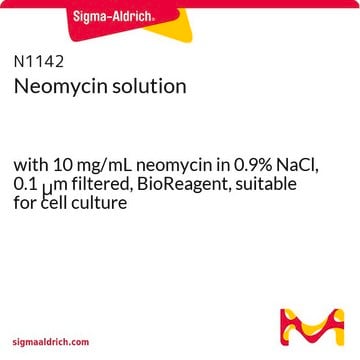If this product has an expiration or retest date, it will be shown on the Certificate of Analysis (COA, CofA). If there is no retest or expiration date listed on the product's COA, we do not have suitable stability data to determine a shelf life. For these products, the only date on the COA will be the release date; a retest, expiration, or use-by-date will not be displayed.
For all products, we recommend handling per defined conditions as printed in our product literature and website product descriptions. We recommend that products should be routinely inspected by customers to ensure they perform as expected.
For products without retest or expiration dates, our standard warranty of 1 year from the date of shipment is applicable.
For more information, please refer to the Product Dating Information document: https://www.sigmaaldrich.com/deepweb/assets/sigmaaldrich/marketing/global/documents/449/386/product-dating-information-mk.pdf
SBR00022
Blasticidin S Ready Made Solution
10 mg/mL (20 mM HEPES), 0.22 μm filtered
Seleccione un Tamaño
Seleccione un Tamaño
About This Item
Productos recomendados
Nivel de calidad
esterilidad
0.22 μm filtered
Ensayo
≥98% (HPLC)
Formulario
liquid
concentración
10 mg/mL (20 mM HEPES)
color
colorless to faint yellow
espectro de actividad antibiótica
fungi
Modo de acción
protein synthesis | interferes
temp. de almacenamiento
−20°C
cadena SMILES
CN(CCC(CC(=O)NC1C=CC(OC1C(=O)O)N2C=CC(=NC2=O)N)N)C(=N)N.Cl
InChI
1S/C17H26N8O5.ClH/c1-24(16(20)21)6-4-9(18)8-12(26)22-10-2-3-13(30-14(10)15(27)28)25-7-5-11(19)23-17(25)29;/h2-3,5,7,9-10,13-14H,4,6,8,18H2,1H3,(H3,20,21)(H,22,26)(H,27,28)(H2,19,23,29);1H
Clave InChI
YQXYQOXRCNEATG-UHFFFAOYSA-N
Categorías relacionadas
Descripción general
In research, Blasticidin S has become a valuable tool, notably as a marker for strain manipulations. Recent applications involve the use of Blasticidin S as a selection agent for cells carrying plasmids conferring blasticidin resistance. The resistance is mediated by the blasticidin S deaminase genes (bsr from Bacillus cereus or BSD from Aspergillus terreus). These genes produce enzymes that catalyze the hydrolytic deamination of the cytosine moiety in blasticidin S, leading to the formation of a non-toxic deaminohydroxy derivative. This resistance mechanism is crucial in various studies involving genetic manipulations and selections in cell biology and biochemical research.
Aplicación
- studies to have fungicidal properties and prevents rice blast disease.[1]
- used as a selection agent for transformed cells that contain the resistance genes bls, bsr, or bsd. Blasticidin S has been used to select HEK293-T cells with TLR-2 constructs and HEK-D5 cells.[2][3]
- used to study protein synthesis at the level of peptide bond formation.
Acciones bioquímicas o fisiológicas
Antimicrobial Spectrum: Active against mycobacteria, several Gram-positive and Gram-negative bacteria
Características y beneficios
- High-quality antibiotic suitable for multiple research applications
- Ideal for Cell Biology and Biochemical research
Otras notas
Palabra de señalización
Danger
Frases de peligro
Consejos de prudencia
Clasificaciones de peligro
Acute Tox. 3 Oral
Código de clase de almacenamiento
6.1D - Non-combustible acute toxic Cat.3 / toxic hazardous materials or hazardous materials causing chronic effects
Clase de riesgo para el agua (WGK)
WGK 1
Punto de inflamabilidad (°F)
Not applicable
Punto de inflamabilidad (°C)
Not applicable
Elija entre una de las versiones más recientes:
Certificados de análisis (COA)
¿No ve la versión correcta?
Si necesita una versión concreta, puede buscar un certificado específico por el número de lote.
¿Ya tiene este producto?
Encuentre la documentación para los productos que ha comprado recientemente en la Biblioteca de documentos.
Los clientes también vieron
-
How can I determine the shelf life / expiration / retest date of this product?
1 answer-
Helpful?
-
-
How is shipping temperature determined? And how is it related to the product storage temperature?
1 answer-
Products may be shipped at a different temperature than the recommended long-term storage temperature. If the product quality is sensitive to short-term exposure to conditions other than the recommended long-term storage, it will be shipped on wet or dry-ice. If the product quality is NOT affected by short-term exposure to conditions other than the recommended long-term storage, it will be shipped at ambient temperature. As shipping routes are configured for minimum transit times, shipping at ambient temperature helps control shipping costs for our customers. For more information, please refer to the Storage and Transport Conditions document: https://www.sigmaaldrich.com/deepweb/assets/sigmaaldrich/marketing/global/documents/316/622/storage-transport-conditions-mk.pdf
Helpful?
-
-
Can you please advise the freeze/thaw cycle of this product?
1 answer-
This product is shipped at ambient temperature and may be stored at 4 °C for up to two weeks. For long term storage, -20 °C is recommended. The solution should be aliquoted prior to freezer storage. Avoid repeated freeze/thaw cycles.
Helpful?
-
Active Filters
Nuestro equipo de científicos tiene experiencia en todas las áreas de investigación: Ciencias de la vida, Ciencia de los materiales, Síntesis química, Cromatografía, Analítica y muchas otras.
Póngase en contacto con el Servicio técnico









